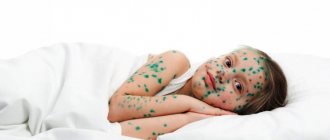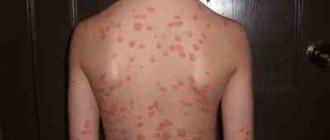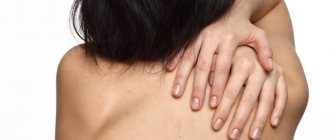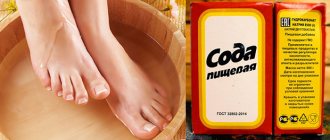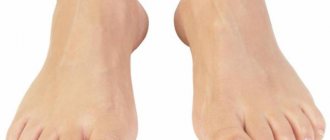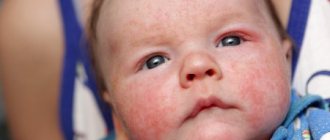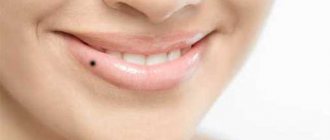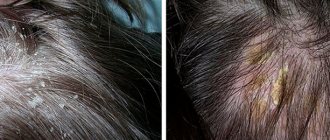Infectious dermatitis causes?
- Diseases that are transmitted after sexual contact: donovanosis, with syphilis.
- A cut. Microbes can penetrate through the wound: staphylococci, with streptococci.
- Poor circulation or significant blood loss. Anemia.
- Intestinal ailments, with stomach.
- Infection after surgery.
Viral dermatitis, what it is, what causes it. Factors:
- From birth or acquired immunity deficiency in chronic form.
- Age. Elderly people and children are more likely to become infected and fall ill.
- Varicose veins or poor patency of veins in a chronic form.
- Chronic diseases: liver; Gastrointestinal tract; endocrine; infections that act in the body in a chronic form.
- Constant intoxication due to work, alcoholism, or other reasons.
- Long-term use of glucocorticosteroids. They can be in the form of a cream or ointment; immunosuppressant.
- Neglect of sanitary and hygienic standards.
- Skin microtraumas.
Even if the reasons why a person can become infected are known, it is not easy to understand what the nature of the infection is. The doctor will say this only after a comprehensive diagnosis. The study will be serological or virological. They are made more often than others. Histology, which is considered a reliable diagnostic method, will also show why dermatitis occurred.
Reasons for appearance
Dermatitis, which is caused by pathogenic flora, often occurs in young children. This is due to the immaturity of the immune system. But such a disease, under the influence of a number of factors, often occurs in adults.
At the moment, all the main causes of infectious dermatitis are known:
- Viral diseases that often occur in childhood (measles, chicken pox, rubella).
- Bacterial coccal flora.
- Candida fungus (rare).
In some cases, dermatitis is observed as a result of damage to the body by sexually transmitted diseases.
Predisposing factors for the development of the disease are all phenomena that provoke a decrease in immunity.
Dermatitis usually occurs under the influence of the following conditions:
- chronic diseases of internal organs;
- sluggish infectious processes;
- low physical activity;
- physical and psycho-emotional overload;
- anemia;
- long-term use of certain medications (cytostatics, glucocorticoids);
- intoxication;
- violation of hygiene;
- burn or hypothermia;
- failure of metabolic processes and the functioning of internal secretion organs (often found in diabetes mellitus);
- genetic predisposition;
- surgical intervention;
- lack or absence of vitamins and other nutrients;
- poor nutrition or fasting.
Infection occurs through contact and blood flow from foci of infection..
About symptoms
A skin disease can occur against the background of some other disease. Symptoms will vary. For example, if viral dermatitis develops in a patient who has had measles, the rash will spread throughout the body, like this:
- on 1 day it will affect the face;
- on 2 - it will gradually appear in different parts of the body;
- 3 days will pass and in addition to the maculopapular rash, the patient’s temperature will rise.
When you have scarlet fever, the rash appears in the form of small blisters. The rash is visible on the body for 2 to 5 days. After this, the resulting crusts peel off.
If a person is sick with typhus, the rash appears 3 to 5 days after infection. The boundaries of the lesion are clear and exciting: the abdomen, with the mammary glands, and the joints of the arms. 2 days will pass and the epithelium will be pigmented.
Chickenpox causes a rash scattered over different areas of the body. Infectious dermatitis affects in the following sequence:
- pink spots form;
- spots become blisters;
- the bubbles fill with water;
- watery blisters burst one after another;
- crusts appear.
In addition to these symptoms, the patient will have a high temperature. Common manifestations of the disease: erythema or rash, itching with swelling on different parts of the body. If the rash has been on the body for a long time, it begins to get wet. This is due to the fact that fluid is released from the blisters, which is the next stage of the disease. Let's look at viral dermatitis in children, photos of chickenpox.
Features of infectious diseases in children and adults
A fifth of all cases of dermatitis are infectious. It is detected by inflammation of the skin and accompanies a number of diseases of an infectious nature. It can develop independently due to injuries, complications after operations.
The disease affects people of any age. In children, it is more often associated with the development of infectious diseases and the penetration of pathobacteria into wounds. Blisters and inflammation that accompany the disease cause itching. It is difficult for a child to resist scratching them.
In adults, pathology appears due to poor hygiene, complications after operations, and sexual diseases.
The places where inflammation spreads are the face, neck, armpit cavities, internal areas of the elbow and knee, and groin area.
Advanced infectious dermatitis leads to the development of meningitis, sepsis, loss of skin sensitivity, and tissue death.
Definition by symptoms
For people who are sick with an infectious skin disease, the symptoms vary. A person can become infected with one of the infections.
Infectious dermatitis symptoms, diagnosis and treatment:
- With rubella, the rash appears on the face and neck. Time will pass and it will spread throughout the skin. Many rashes appear on: buttocks, arms, legs, back. Rubella rash is accompanied by lymphadenitis with hyperthermia. At first the spots will be small and oval. 2 days will pass, they will turn pale and disappear.
- The measles rash primarily affects the ears. Then it crawls onto the front part, to the bridge of the nose, fills the entire face, and goes along the neck to the chest. 2 days will pass and damage to the skin of the arms and legs will occur. At stage 1, the rash will be pinkish, similar to papules. Then they combine into 1 larger one and turn red, acquiring brightness. A day will pass from the moment of redness and the affected area will become dark red and peeling will begin. For some, the spots take on a purple or greenish tint, and may turn brown on the 3rd or 4th day.
- If the rash occurs on the lower extremities, this may be a sign of enterovirus infection. First, bacterial dermatitis is noticeable on the arms and legs, then spreads throughout the body. They quickly become pigmented and peel off.
- Scarlet fever is now rare, but most people have heard of this disease. Acne will be thick and cover large areas of the body. The rash is bluish and small. The disease affects places where there is a lot of moisture - these are the armpits and groin. With scarlet fever, the patient has a high body temperature. Sweat causes the rash to spread over the skin in children and adults. Most rashes occur on the stomach, back, elbows, and other places. The rashes are pustular, with hemorrhages under the skin. With this disease, acne on the legs will appear last.
- Many children suffer from chickenpox in kindergartens. The route of infection of the skin is airborne. The patient has pimples all over his body that burst. The infectious liquid will get onto both clean areas of the skin and the skin of a child or adult who is nearby. You get chickenpox once in your entire life and only in childhood. The rash will be all over the body: on the head, in the ears, in the groin, on the fingertips.
- The rash tries to have a negative effect on the human nervous system. This happens due to shingles. Scabies often appears due to poor hygiene, when a person has dirty hands for a long time and becomes infected. First, viral dermatitis in adults and children affects the hands. Then the patient itches and gradually the infection spreads to the whole body. Only the back remains uninfected with scabies. The patient itches and infected particles remain on clothes and can get into food. So, other people become infected. Scabies can be cured in 3 days. The main thing is that the doctor correctly diagnoses and prescribes treatment.
Treatment methods
The approach to treatment is determined by the cause of infectious dermatitis. Various medications are used in the treatment of children and adults.
Treatment uses antiseptic ointments and solutions to prevent the spread of infection to neighboring areas.
If bacterial dermatitis is detected, broad-spectrum antibiotics – Erythromycin – are used. Ointments (Sintomycin) are prescribed.
Relieve swelling and inflammation with ointments containing glucocorticosteroids - Advantan, Dexamethasone.
The use of antihistamines is indicated - Zyrtec, Ceritisin. Their use helps reduce itching and other manifestations of allergies.
To combat fungal infections, Triderm and Pimafucort are used.
The therapy uses UHF, ozone therapy, and magnetic therapy.
About diagnostics
When an adult or child develops a rash on some part of the body, it becomes clear that the person is sick. To establish a diagnosis and prescribe treatment, an adult needs to see a doctor. The patient undergoes a dermatological examination. Viral dermatitis in children - treatment will be prescribed by a pediatrician.
The doctor scrapes the affected area and sends the sample to the laboratory. There a culture (bacteriological) is done and the virus is determined. Another reliable way to determine infection: serological, with virological. If, based on these data, the doctor finds it difficult to establish an accurate diagnosis, he resorts to histological examination of the biopsy specimen.
Main forms of dermatitis
The disease described is the body’s response to all kinds of irritants. The disease manifests itself in chronic and acute forms.
The chronic form of dermatitis is a recurring disease process, which manifests itself as a result of lack of therapy or in the conditions of an incorrect and ineffective treatment course. The manifestation of this type of pathology is usually caused by the appearance of a small rash on the skin. It is noted that in conditions of chronic dermatitis there is no inflammatory process. Prediction of the outcome of the disease occurs through diagnosis and thorough examination.
Acute dermatitis is characterized by local manifestations, which include:
- the appearance of sudden itching on the skin;
- the presence of a low temperature (the temperature in this case is 37-37.5 degrees);
- the occurrence of a mild runny nose.
Signs characterizing acute dermatitis may indicate an allergic or atopic form of the disease. If there is a protrusion of a local rash, then this indicates infectious dermatitis.
What should I do to heal?
Any skin disease due to infection is considered complex. After diagnosis, it is treated comprehensively.
Infectious dermatitis - treatment is carried out with various ointments, gels, creams, sprays, which are applied directly to the affected areas. They are used until all signs of the disease disappear. The main thing is to cure completely so that there is no relapse.
Use of therapy
The attending physician prescribes physiotherapy to the patient:
- Ural Federal District;
- ozone therapy.
- magnetic therapy;
- UHF;
- laser therapy;
Use of medications
As prescribed by the doctor, to cure infectious dermatitis, patients use various medications:
- if the rash is caused by fungi, then use medications that kill fungi;
- antibacterial;
- products containing corticosteroids;
- antihistamines;
- antibiotics when the rash is caused by bacteria;
- anti-inflammatory.
Medicines help remove swelling, itching, rashes, and cope with weeping. A skin disease caused by an infection can be treated at home.
Traditional methods
Not everyone wants to be treated with medications, since they are not harmless to the body. There is an alternative - traditional methods. Once upon a time, our ancestors did not have modern medicines; they treated all ailments with herbs, made ointments, lotions, and compresses based on them.
Infectious dermatitis is caused by infection with a virus. First, the patient should go to see a dermatologist. He will examine him, make a preliminary diagnosis, take a smear, blood test and even a scraping for examination. When the test results are ready, the doctor will either confirm the preliminary diagnosis, or it will be different. The main thing is that it is faithful. Before using any folk remedies, you should consult your doctor.
Consider popular folk recipes for treating infectious dermatitis:
- Grind raw potatoes on a fine grater. It helps relieve itching with abscess. Grated potatoes are placed on the rashes and covered with a cotton cloth. Keep the compress for about 30 minutes, and then wash off under warm running water. The skin needs to be wiped so that it is dry. As expected, potatoes in 1-3 minutes. will relieve abscesses, with itching, swelling, burning.
- A creamy ointment with butter (fat content 72% or higher) + an infusion of St. John's wort helps well. You will need 0.5 cups of infusion. Requires 1.5 tbsp. l. grass for this volume of water. You need to insist for 15 minutes and strain. Soft butter is added to the infusion of St. John's wort. Mix everything and rub in a circular motion onto the affected areas of the body for 15 minutes until absorbed. The mixture is not washed off.
How contagious the patient is after these procedures can be understood after 3 days. If the skin condition has not improved significantly, then you need to see a doctor and he will prescribe treatment. This is how serious illnesses are treated. Scabies is neutralized with the help of special anti-rash medications.
Alternative medicine
To consolidate the therapeutic effect, you can use folk remedies. They combat symptoms but should not replace primary treatment.
- Children and adults are recommended to take baths with a decoction of string and chamomile. For a liter of boiling water you will need 5 tablespoons of flowers. The mixture is kept in a water bath for 10-12 minutes, filtered after cooling and poured into the bath.
- Grind the grass and flowers of fresh St. John's wort. Pour 25 g of raw material with a glass of vegetable oil. Pour into an opaque container and keep warm for 2 weeks. Apply the strained oil to the affected areas twice a day.
- Raw mashed potatoes are applied to sore areas of the skin to soften and speed up healing. The duration of the procedure is 15 minutes.
Preventive measures
Dermatitis that occurs due to infection cannot be avoided, since a person may not know from whom he will get infected? Medicines or folk remedies will help alleviate the patient’s condition. It is important to heal the skin as soon as possible.
If you follow certain rules, the risk of infection is reduced:
- Minimum contact with the sick person.
- Maintain personal hygiene.
- Increase immunity.
- When the first signs of the disease appear, immediately go to an appointment with a dermatologist.
Prevention measures
It is possible and necessary to minimize the likelihood of developing ID. To do this, you need to make it a rule to perform the following activities:
- Maintain personal hygiene. In addition to keeping the skin clean, monitor its moisture level and avoid excessive drying.
- Do not come into contact with objects, people and animals that could be a source of infection.
- Healthy eating (a nutritious diet containing essential nutrients).
- Physical activity.
- Do not indulge in bad habits: avoid smoking and alcoholic beverages.
- Perform hardening procedures.
- At the first suspicion of ID, immediately go to the doctor.
ID disease can be prevented, but the likelihood of its occurrence cannot be completely eliminated. After all, it is impossible to create an absolutely sterile environment without pathogenic microbes and bacteria.
Share with friends
Rate this article
About complications
If the patient turned to a dermatologist too late or was treated only with folk remedies, something he chose on his own, he may experience complications. When the patient has not completely cured the disease, relapses occur. For some, the disease becomes chronic. Infectious dermatitis - photos can be viewed on the Internet.
The severe consequences of infection with infectious dermatitis are:
- scarring of the dermis;
- depigmentation;
- hyperpigmentation process.
When a patient goes to see a dermatologist right away, the doctor promptly makes the correct diagnosis - infectious dermatitis, prescribes treatment, and the disease quickly passes. If a person consulted a doctor too late, was treated only with folk remedies, did not buy or use medicines or used them little, his illness progresses in a chronic form.
Clinical picture
In humans, this type of dermatitis manifests itself with the following symptoms:
- spots and rashes on the skin,
- itching,
- weakness, fever, elevated temperature (optional).
In severe cases, the rash turns into eczema, and re-infection of the inflammation is possible. As you can see in the photo below, the rash may look like papules with liquid. Periodically, they burst and form scales similar to seborrhea or psoriasis.
Failure to see a doctor in a timely manner can lead to a number of complications, including: skin scarring (scars), vitiligo, hyperpigmentation.

